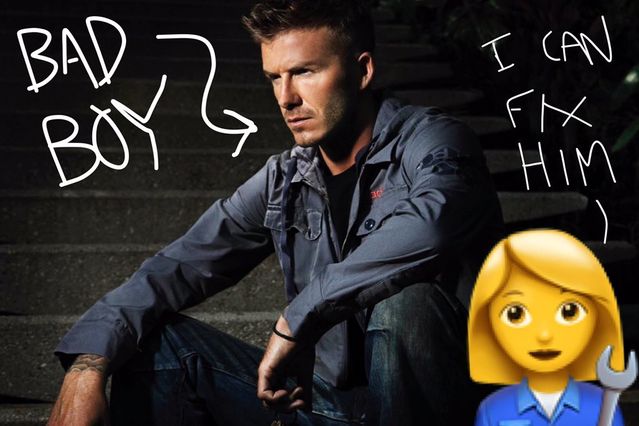Happiness
What Is the Sexiest Emotion for Men to Display?
Emotion research may help to explain the sexual appeal of bad boys.
Posted July 27, 2017 Reviewed by Matt Huston
So you tried loving yourself on the inside but that didn’t work. Now to distract from the inner turmoil, you seek external validation by trying to appear as sexually attractive as possible. Well, you've come to the right place.
Aesthetics 101 reveals what men and women find most sexually attractive in the opposite sex—based NOT on opinion, but on published empirical data. (Think of it as Cosmo meets Cosmos... or Perez Hilton meets PNAS.)
For my first post, I thought I'd kick it off by answering a question I've tackled in some of my own scientific research: What is the sexiest emotion for men to display?
In two studies using various methods and photographs, my colleague Jessica Tracy and I asked women to rate the sexual attractiveness of men displaying either pride, shame, happiness, or neutrality. (Full article can be found here: Tracy & Beall, 2011.) Here’s what we found:
Male Happiness Is Not Very Attractive
Somewhat surprisingly, we found that happiness was consistently rated as the least sexually attractive male emotion expression. (For an un-peer-reviewed—but cool—conceptual replication of our happiness findings check out this post from OKCupid using real-life smiling vs. non-smiling dating profile photos.)

You might think that happiness would be attractive to women because it communicates a man’s friendliness and approachability; smiling tends to elicit trust and approach-oriented behaviors (Becker, Kenrick, Neuberg, Blackwell, & Smith, 2007; Brown, Palameta, & Moore, 2003).
However, when it comes to judging carnal sexual attractiveness, the social communicative messages sent by male happiness could be construed by women as neediness or desperation. Indeed, showing happiness and appearing friendly can be great… If you’re looking for a platonic female friend.
Male Shame Is Pretty Attractive
In our studies, male shame displays were judged as relatively sexually attractive (especially among younger women); male shame was more attractive than male happiness, and not substantially less than male pride.

The shame expression is an appeasement display; it signals that the expresser has violated a social norm—BUT the expresser is also aware of their transgression and feels regret (Gilbert, 2007; Keltner, 1995). Put differently, expressing shame serves as a sincere communication of past mistakes while simultaneously inspiring hope that the expresser is capable of one day changing his ways. Any woman who has ever tried to save a “bad boy” can attest to the romantic appeal of this often misguided plight.
Male Pride Is Very Attractive
In our investigation, we found that pride was consistently rated as the most attractive male emotion expression.

Previous studies have shown that men displaying pride are perceived as higher status than men showing a range of other emotions (e.g., Shariff & Tracy, 2009). So, we essentially confirmed what every 65-year-old male CEO with a Ferrari has known for ages: Women are attracted to high-status men (see Buss, 2008).
In addition to the high-status social communicative message sent by pride, the expanded nature of the pride expression’s physical components may also accentuate men’s musculature and upper-body size—both of which can increase men’s attractiveness to women (Li & Kenrick, 2006).
Share this post with someone who never smiles in photos =]
Thanks for reading! I want to know your thoughts. Please comment below:
- What do you think is the sexiest male emotion expression?
- Do you agree/disagree with the findings?
- Did I miss some important research?
References
Becker, D., Kenrick, D., Neuberg, S., Blackwell, K., & Smith, D. (2007). The confounded nature of angry men and happy women. Journal of Personality and Social Psychology, 92, 179–190.
Brown, W., Palameta, B., & Moore, C. (2003). Are there nonverbal cues to commitment? An exploratory study using the zero-acquaintance video presentation paradigm. Evolutionary Psychology, 1, 42–69.
Ekman, P. (2003). Emotions revealed: Recognizing faces and feelings to improve communication and emotional life. New York: Times Books/Henry Holt and Co.
Li, N., & Kenrick, D. (2006). Sex similarities and differences in preferences for short-term mates: What, whether, and why. Journal of Personality and Social Psychology, 90, 468–489.
Martens, J. P., Tracy, J. L., & Shariff, A. F. (2012). Status signals: Adaptive benefits of displaying and observing the nonverbal expressions of pride and shame. Cognition & Emotion, 26, 390-406.
McGee, E., & Shevlin, M. (2009). Effect of humor on interpersonal attraction and mate selection. The Journal of Psychology, 143(1), 67-77.
Shariff, A. F., & Tracy, J. L. (2009). Knowing who’s boss: Implicit perceptions of status from the nonverbal expression of pride. Emotion, 9, 631–639.
Tracy, J. L., & Beall, A. T. (2011). Happy guys finish last: The impact of emotion expressions on sexual attraction. Emotion, 11, 1379-1387.
Tracy, J. L., & Robins, R. W. (2004). Show your pride: Evidence for a discrete emotion expression. Psychological Science, 15, 194-197.
Tracy, J. L., & Robins, R. W. (2007). The prototypical pride expression: Development of a nonverbal behavioral coding system. Emotion, 7, 789-801.
Tracy, J. L., Shariff, A. F., Zhao, W., & Henrich, J. (2011). Cross-cultural evidence that the pride expression is a universal automatic status signal. Under review.


